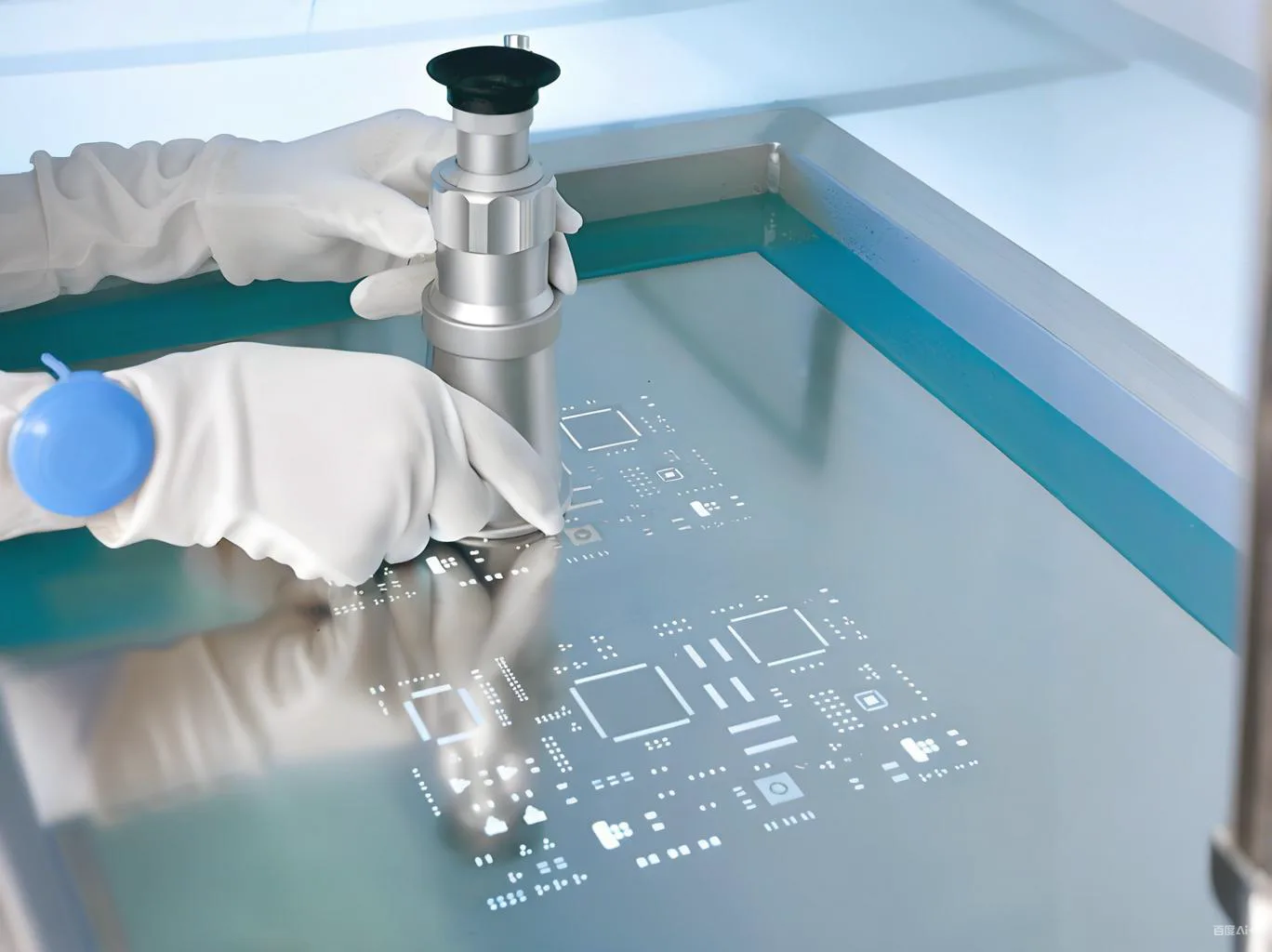소개: SMT 제조에서 스텐실 장력의 중요한 역할
정밀하게 움직이는 세계에서 PCB 조립, 스텐실 장력은 솔더 페이스트 인쇄 품질과 최종 제품 신뢰성에 직접적인 영향을 미치는 기본 매개변수를 나타냅니다.. 그 중요성에도 불구하고, 장력 측정의 적절한 위치(전면 또는 후면)와 관련하여 전자 제조 산업 전반에 걸쳐 혼란이 지속되고 있습니다..

업계 데이터는이를 보여줍니다 87% 전자 제조 기업의 표준 방법론으로 후면 테스트를 지속적으로 활용합니다., 신품의 경우 장력 사양을 35N/cm 이상 유지하면서 스텐실 활성 서비스 중인 스텐실의 경우 최소 25N/cm.
스텐실 장력의 기본 이해
스텐실 장력이란 무엇입니까??
스텐실 장력은 스텐실 표면이 견딜 수 있는 단위 길이당 힘을 나타냅니다., 일반적으로 측정 뉴턴/센티미터 (n/cm). 이 매개변수는 스텐실 메시의 긴장 정도를 정량화합니다., 페이스트 방출 특성과 인쇄 일관성에 직접적인 영향을 미칩니다. SMT 어셈블리 프로세스.
SMT 인쇄 품질에 대한 중요한 영향
적절한 스텐실 장력은 스텐실과 스텐실 사이의 최적의 접촉을 보장합니다. PCB 패드 표면, 정확한 솔더 페이스트 증착 촉진. IPC-7525A 지침에 따르면, 부적절한 장력 측정은 고밀도 인쇄 결함의 주요 원인을 나타냅니다. PCB 디자인.
업계 데이터에 따르면 장력 값이 25N/cm 미만으로 떨어지는 스텐실은 300% 인쇄 불량 증가, 솔더 브리징 포함, 페이스트가 부족하다, 그리고 타협하는 오정렬 문제 PCB 신뢰할 수 있음.
프론트 대. 뒷면 테스트 토론
전면 테스트 방법론
전면 테스트에는 솔더 페이스트 도포 공정 중 PCB와 접촉하는 인쇄 표면의 장력을 측정하는 작업이 포함됩니다.. 지지자들은 이 접근 방식이 페이스트 전달 효율성에 영향을 미치는 작동 조건을 가장 정확하게 반영한다고 주장합니다..
하지만, 상당한 제한이 존재함:
-
정밀 에칭된 구멍이 손상될 위험이 있습니다.
-
중요한 인쇄 표면의 오염 가능성
-
표면 처리로 인한 측정 불일치
뒷면 테스트의 장점
뒷면 테스트, 인쇄되지 않은 표면에서 수행됨 (스퀴지 쪽), 으로 등장했습니다. 업계에서 선호하는 방법론 실질적인 고려 사항과 위험 완화를 바탕으로.
물리적 원리 지원 이 접근법: 장력은 스텐실 메시 전체에 분포된 고유한 재료 특성을 나타냅니다.. 어느 표면에서나 측정한 결과는 이론적으로 표준 측정 허용 오차 내에서 동일한 결과를 산출해야 합니다..
실질적인 이점은 다음과 같습니다.:
-
인쇄 표면 손상 위험 제거
-
일관된 측정 조건
-
생산 중단 최소화
-
자동화된 테스트 장비와의 호환성
IPC 표준 분석
IPC-7525B: 스텐실 디자인 지침
IPC-7525B 표준은 스텐실 제작 및 품질 보증에 대한 기본 요구 사항을 설정하지만 특정 테스트 위치 프로토콜과 관련하여 의도적인 모호성을 유지합니다.. 이 표준은 규정적인 테스트 위치 규정을 피하면서 스텐실 서비스 수명 전반에 걸쳐 인장 유지를 강조합니다..
업계 해석 및 구현
하는 동안 IPC 표준 절차적 사양이 아닌 성능 요구 사항을 제공합니다., 업계 모범 사례를 통해 명확한 구현 프레임워크가 확립되었습니다.. 주요 전자 제조업체와 스텐실 공급업체는 실질적인 제조 제약 사항을 해결하면서 IPC 품질 목표에 부합하는 표준화된 테스트 프로토콜을 개발했습니다..
표준 테스트 절차: 5단계 방법론
준비 및 교정
-
환경 설정: 안정적인 표면에 스텐실을 수평으로 배치
-
표면 준비: 오염을 제거하기 위해 측정 영역을 청소하십시오.
-
기기 교정: 참조 표준을 사용하여 장력 측정기 교정 확인
측정 프로토콜
구현 5점 측정 방법:
-
네 모퉁이 위치 (15-20프레임 가장자리에서 cm)
-
하나의 중앙 위치
-
일관된 적용 압력
-
메시 방향에 따른 평행 정렬
테이블: 표준 스텐실 장력 테스트 절차
| 단계 | 행동 | 사양 | 품질검사 |
|---|---|---|---|
| 1 | 표면 준비 | ISO 14644-1 수업 7 환경 | 육안검사 |
| 2 | 장력 측정기 설정 | 유효한 교정 인증서 | 영점 검증 |
| 3 | 포인트 측정 | 5 스텐실당 위치 | 일관된 접촉 압력 |
| 4 | 데이터 기록 | 0.1N/cm 분해능 | 실시간 문서화 |
| 5 | 결과 분석 | 승인 기준과 비교 | 추세 모니터링 |
수용 기준 및 의사 결정
새로운 스텐실 측정 지점 간 변동이 5N/cm 미만이고 35N/cm를 초과하는 장력 값을 입증해야 합니다.. 활성 생산 스텐실 25N/cm 이상의 장력을 유지하면 계속 사용하기에 적합합니다., 이 임계값 아래로 떨어지는 제품은 PCB 품질 표준을 보장하기 위해 즉각적인 교체가 필요합니다..
고급 테스트 기술 및 방법론
자동화된 장력 모니터링 시스템
산업 4.0 이니셔티브를 통해 통합 스텐실 관리 시스템 개발이 주도되었습니다.:
-
자동화된 장력 매핑
-
실시간 데이터 수집
-
예측 교체 알고리즘
-
디지털 트윈 통합
특수 스텐실 애플리케이션
다음을 포함한 고급 스텐실 기술 전기 주조 스텐실, 나노 코팅 표면, 그리고 단계 설계 구성 수정된 테스트 접근 방식이 필요합니다.. 제조업체는 고유한 구조적 특성을 수용하면서 측정 무결성을 유지하는 애플리케이션별 테스트 프로토콜을 확립하기 위해 스텐실 공급업체와 협의해야 합니다..
구현 프레임워크 및 모범 사례
품질 관리 통합
성공적인 스텐실 장력 관리를 위해서는 품질 관리 시스템에 대한 포괄적인 통합이 필요합니다.:
문서 요구 사항:
-
스텐실 수명 추적 기록
-
정기적인 교정 일정
-
운영자 교육 인증
-
통계적 공정 관리 데이터
예방적 유지보수:
-
예정된 장력 검증
-
점진적인 교체 계획
-
고장 모드 분석
-
지속적인 개선 활동
직원 교육 및 인증
작업자 역량은 측정 신뢰성과 프로세스 일관성에 직접적인 영향을 미칩니다.. 다음과 같은 체계적인 교육 프로그램을 시행합니다.:
-
장력이론의 기초
-
적절한 악기 취급
-
측정기술 표준화
-
데이터 해석 기술
-
문제 해결 방법론
사례 연구: 제조 우수 성과
선도적인 자동차 전자 장치 제조업체는 글로벌 생산 시설 전반에 걸쳐 표준화된 후면 스텐실 장력 테스트를 구현했습니다., 획기적인 품질 개선 달성:
핵심 성과 지표:
-
스텐실 장력 관련 결함 감소 68%
-
스텐실 서비스 수명이 다음으로 연장되었습니다. 80,000 사이클
-
인쇄 품질 일관성이 향상되었습니다. 98% 능력 지수
-
연간 스텐실 조달 비용 절감 32%
성공 요인:
-
통합 테스트 방법론 구현
-
첨단 장력 모니터링 장비
-
종합적인 운영자 인증
-
데이터 기반 교체 결정
결론 및 권장 사항
스텐실 장력 테스트는 SMT 제조에서 중요한 품질 보증 활동을 나타냅니다., 솔더 페이스트 프린팅 성능과 최종 제품 신뢰성에 직접적인 영향을 미칩니다.. IPC 표준은 테스트 위치를 지정하지 않고 성능 요구 사항을 설정하는 반면, 업계 합의는 실질적인 고려 사항과 위험 관리 원칙을 기반으로 한 후면 테스트 방법을 강력히 선호합니다..
구현 권장 사항:
-
표준화된 뒷면 테스트 프로토콜 확립
-
장력 측정 장비에 대한 정기적인 교정 일정 구현
-
포괄적인 스텐실 수명주기 추적 시스템 개발
-
장력 모니터링을 통계적 공정 제어에 통합
-
지속적인 운영자 교육 및 인증 제공
처럼 전자 구성 요소 소형화 및 복잡성 증가를 향한 지속적인 노력, 정확한 스텐실 장력 관리가 제조 성공에 점점 더 중요해지고 있습니다.. 강력한 테스트 프로토콜을 구현하면 일관된 인쇄 품질이 보장됩니다., 결함률 감소, 그리고 전체 스텐실 활용을 최적화합니다. PCBA 제조 프로세스.